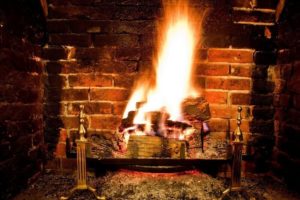 Creosote happens when you burn a fire. Burning fires all winter long and some during the “bridge” seasons, can lead to a large enough accumulation of creosote in a chimney flue to cause problems.
Creosote happens when you burn a fire. Burning fires all winter long and some during the “bridge” seasons, can lead to a large enough accumulation of creosote in a chimney flue to cause problems.
Each and every fire results in small amounts being deposited onto the sides of the flue. Traces of creosote are in the smoke that rises from fire. As the smoke travels upward and mixes with cooler air and moisture nearer the top, it liquefies and then solidifies and sticks to the inside of the chimney. This narrows the passageway, which restricts ventilation, which in turn causes more creosote to accumulate. As efficiency decrease with your fireplace, more creosote is accumulated in the flue. If left unaddressed, this process will continue (layer by layer) until something happens (i.e. achimney fire or blockage) that renders the chimney unusable.
What’s wrong with creosote? Is it really dangerous?
The main issue with creosote is that it’s flammable. It burns…layer by layer. As the amount of creosote inside the chimney flue increases so does your risk of a serious chimney fire. Worst case scenario, chimney fires can cause loss of homes and lives. Less seriously , but still expensive to repair, chimney fires can break the inside of your chimney. The National Fire
Protection Association Standard 211 stipulates that cracked flue tiles must be repaired or replaced.
How to prevent creosote buildup….
The key is regular maintenance. You can interrupt the layering process by having your chimney inspected annually and cleaned whenever the buildup is sufficient to need removal. When you schedule regular service, your creosote buildup will be minimal. Stage 1 and Stage 2 creosote (see our previous blog about creosote) can often be removed by traditional or rotary brushing systems. Stage 3 (the tar like stuff) will not brush out and requires a specialized removal process. Our technicians are trained in various glazed creosote removal options and can determine which is best for your situation.
Dry seasoned wood can help with creosote build-up, but more importantly not inhibiting airflow to the fire and not slowing the speed of the gases exiting the chimney will make a greater impact on the amount of creosote that forms in your fireplace or woodstove flue.
The benefit of annual inspections…..
The Chimney Safety Institute of America (CSIA) and the National Fire Protection Association (NFPA) both recommend annual inspections to keep your chimney operating efficiently and to minimize risk factors. Our trained technicians inspect your system from top to bottom to determine any factors that impact safety, usability and functionality. Our report lets you know any issues we find and corresponding suggested resolutions.
If you have concerns about your chimney system, call schedule a visit with our professionals at Blue Sky Chimney Sweeps|Bless Your Hearth now!
